steering wheel TOYOTA YARIS HYBRID 2013 Workshop Manual
[x] Cancel search | Manufacturer: TOYOTA, Model Year: 2013, Model line: YARIS HYBRID, Model: TOYOTA YARIS HYBRID 2013Pages: 700, PDF Size: 28.68 MB
Page 375 of 700
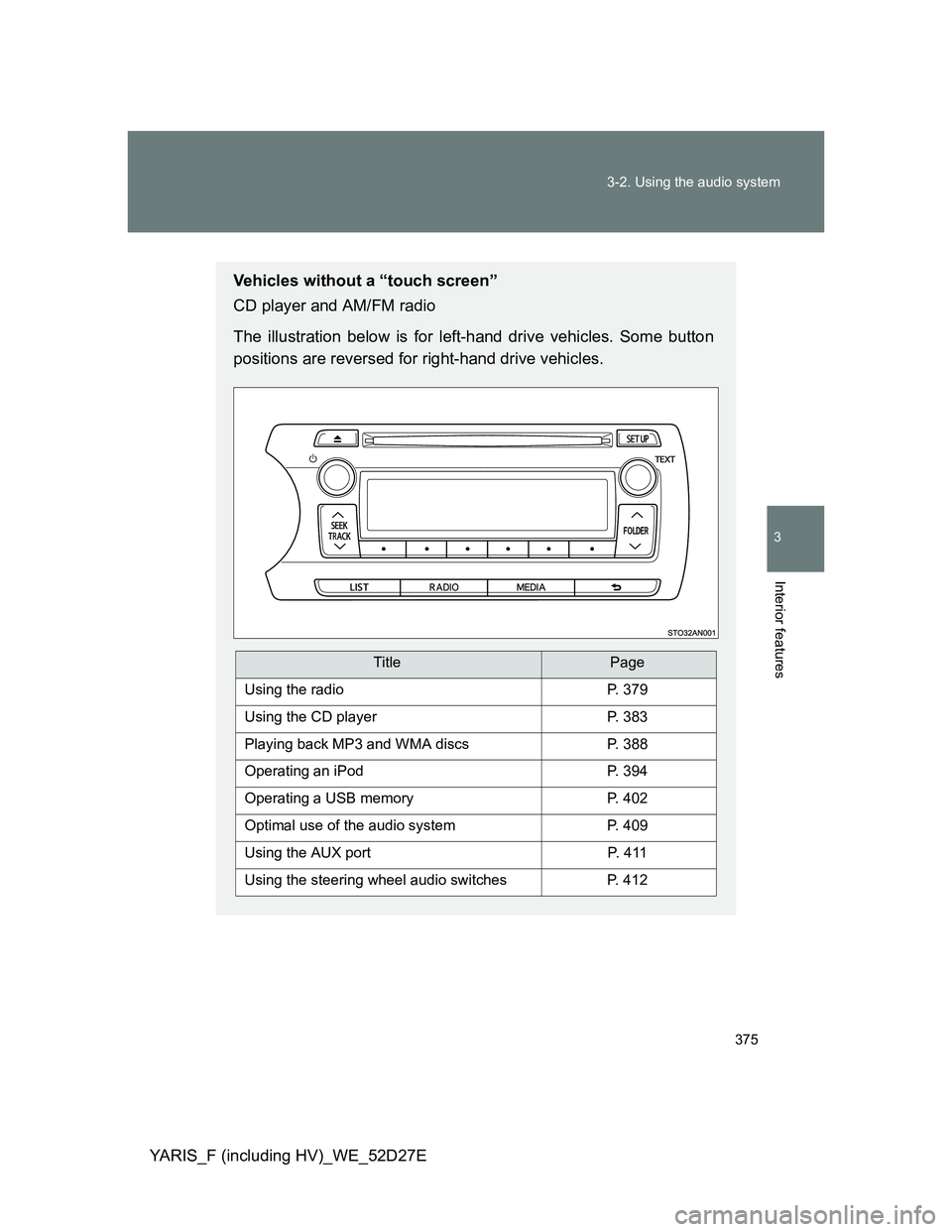
375 3-2. Using the audio system
3
Interior features
YARIS_F (including HV)_WE_52D27E
Vehicles without a “touch screen”
CD player and AM/FM radio
The illustration below is for left-hand drive vehicles. Some button
positions are reversed for right-hand drive vehicles.
TitlePage
Using the radioP. 379
Using the CD playerP. 383
Playing back MP3 and WMA discsP. 388
Operating an iPodP. 394
Operating a USB memoryP. 402
Optimal use of the audio systemP. 409
Using the AUX portP. 4 1 1
Using the steering wheel audio switchesP. 412
Page 412 of 700
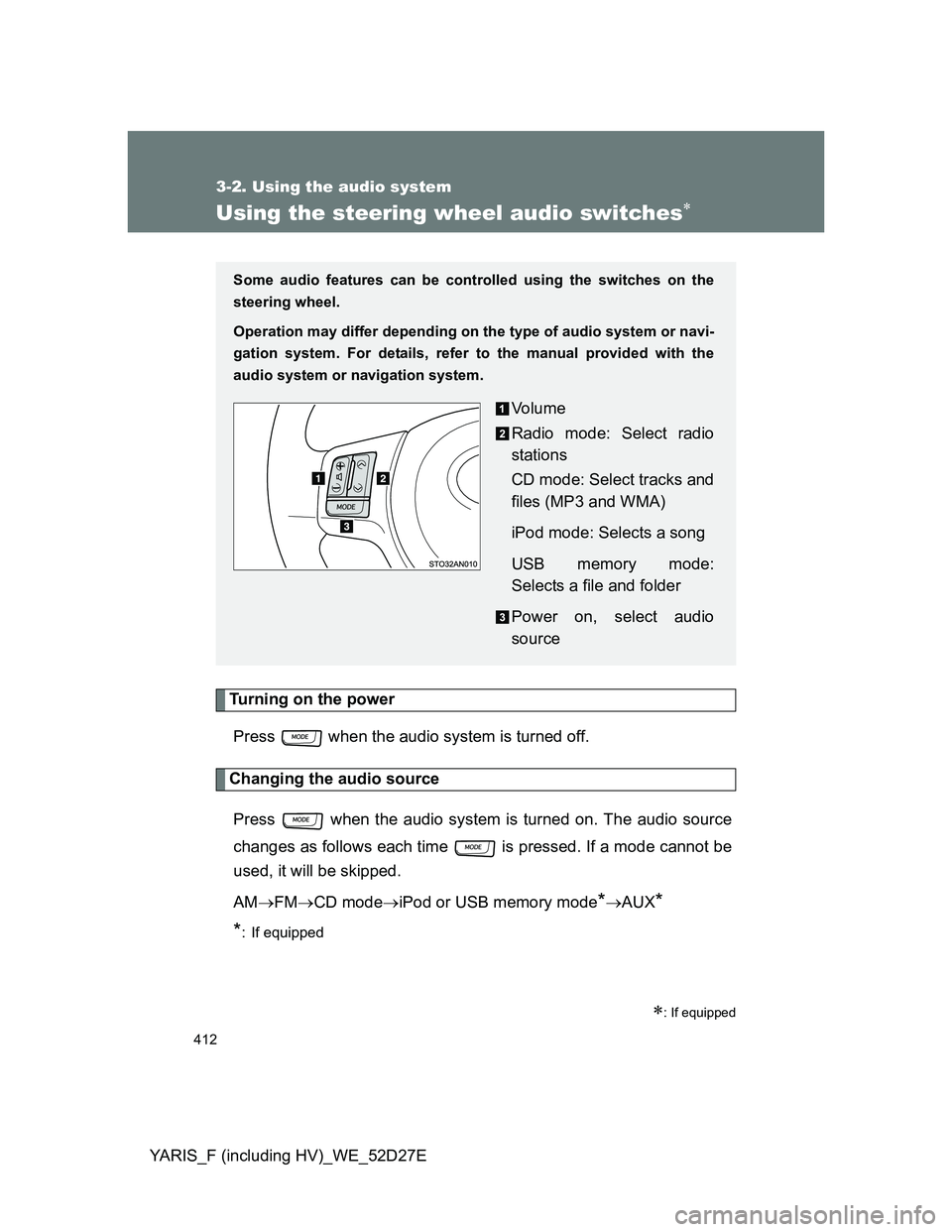
412
3-2. Using the audio system
YARIS_F (including HV)_WE_52D27E
Using the steering wheel audio switches
Turning on the power
Press when the audio system is turned off.
Changing the audio source
Press when the audio system is turned on. The audio source
changes as follows each time is pressed. If a mode cannot be
used, it will be skipped.
AMFMCD modeiPod or USB memory mode
*AUX*
*
: If equipped
: If equipped
Some audio features can be controlled using the switches on the
steering wheel.
Operation may differ depending on the type of audio system or navi-
gation system. For details, refer to the manual provided with the
audio system or navigation system.
Vo l u m e
Radio mode: Select radio
stations
CD mode: Select tracks and
files (MP3 and WMA)
iPod mode: Selects a song
USB memory mode:
Selects a file and folder
Power on, select audio
source
Page 414 of 700
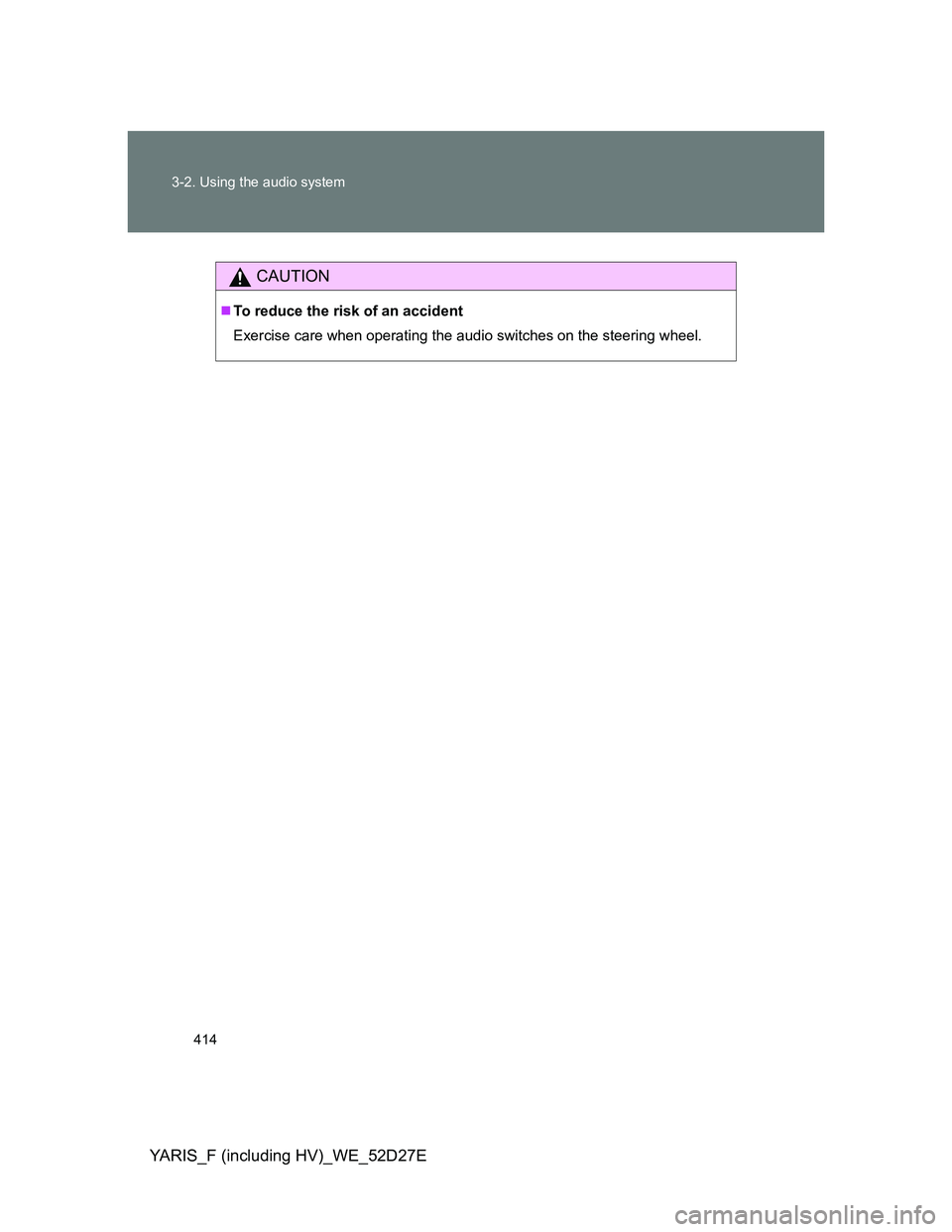
414 3-2. Using the audio system
YARIS_F (including HV)_WE_52D27E
CAUTION
To reduce the risk of an accident
Exercise care when operating the audio switches on the steering wheel.
Page 550 of 700
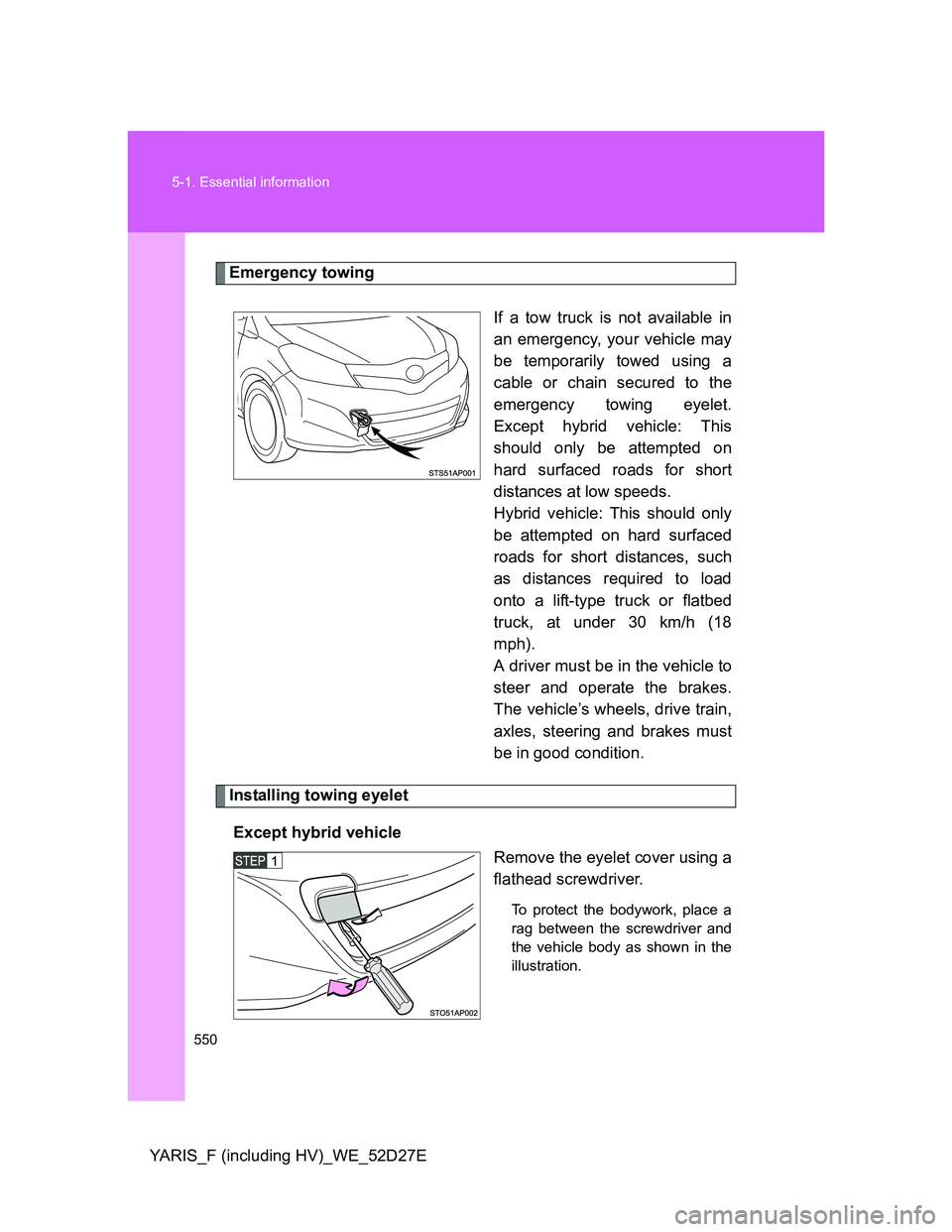
550 5-1. Essential information
YARIS_F (including HV)_WE_52D27E
Emergency towing
If a tow truck is not available in
an emergency, your vehicle may
be temporarily towed using a
cable or chain secured to the
emergency towing eyelet.
Except hybrid vehicle: This
should only be attempted on
hard surfaced roads for short
distances at low speeds.
Hybrid vehicle: This should only
be attempted on hard surfaced
roads for short distances, such
as distances required to load
onto a lift-type truck or flatbed
truck, at under 30 km/h (18
mph).
A driver must be in the vehicle to
steer and operate the brakes.
The vehicle’s wheels, drive train,
axles, steering and brakes must
be in good condition.
Installing towing eyelet
Except hybrid vehicle
Remove the eyelet cover using a
flathead screwdriver.
To protect the bodywork, place a
rag between the screwdriver and
the vehicle body as shown in the
illustration.
Page 557 of 700
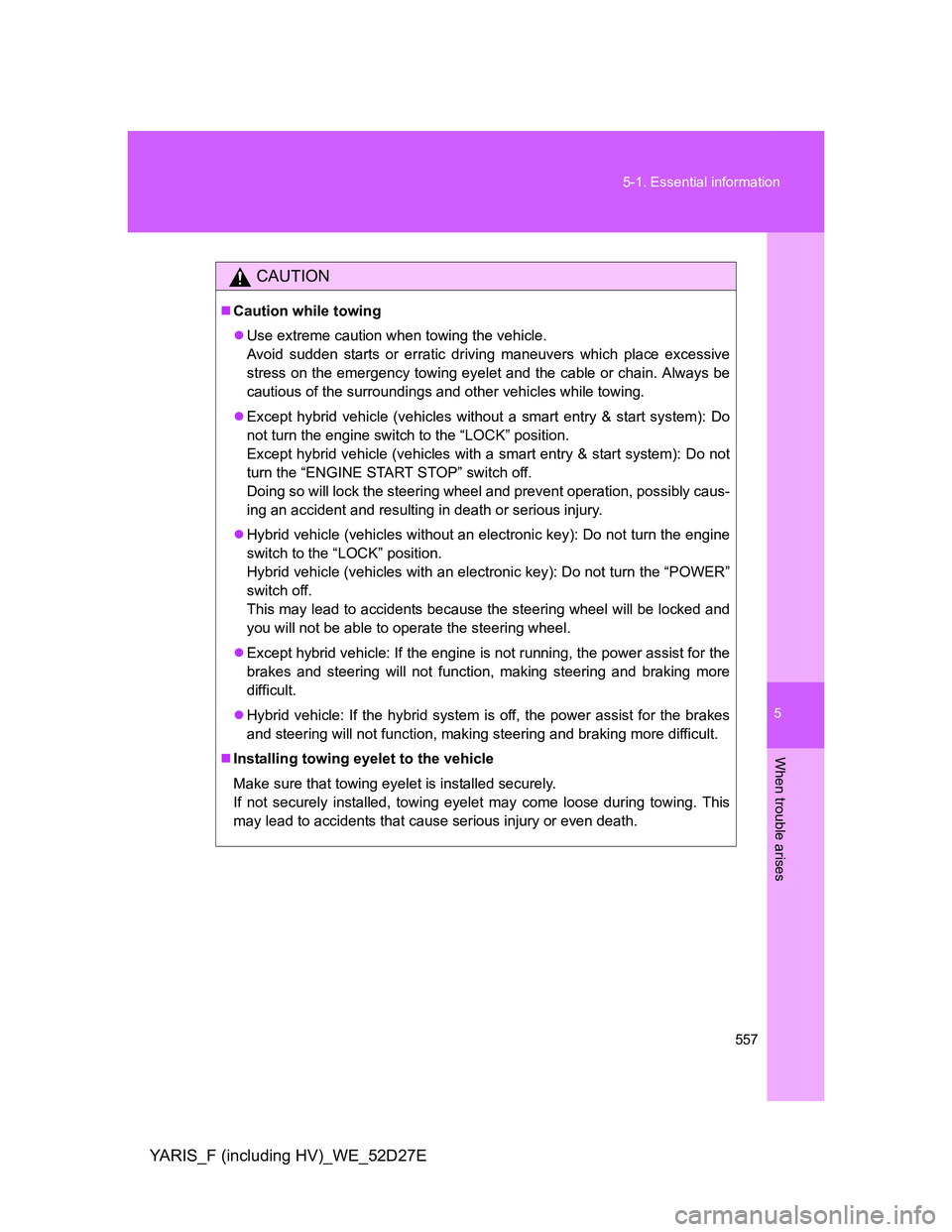
5
557 5-1. Essential information
When trouble arises
YARIS_F (including HV)_WE_52D27E
CAUTION
Caution while towing
Use extreme caution when towing the vehicle.
Avoid sudden starts or erratic driving maneuvers which place excessive
stress on the emergency towing eyelet and the cable or chain. Always be
cautious of the surroundings and other vehicles while towing.
Except hybrid vehicle (vehicles without a smart entry & start system): Do
not turn the engine switch to the “LOCK” position.
Except hybrid vehicle (vehicles with a smart entry & start system): Do not
turn the “ENGINE START STOP” switch off.
Doing so will lock the steering wheel and prevent operation, possibly caus-
ing an accident and resulting in death or serious injury.
Hybrid vehicle (vehicles without an electronic key): Do not turn the engine
switch to the “LOCK” position.
Hybrid vehicle (vehicles with an electronic key): Do not turn the “POWER”
switch off.
This may lead to accidents because the steering wheel will be locked and
you will not be able to operate the steering wheel.
Except hybrid vehicle: If the engine is not running, the power assist for the
brakes and steering will not function, making steering and braking more
difficult.
Hybrid vehicle: If the hybrid system is off, the power assist for the brakes
and steering will not function, making steering and braking more difficult.
Installing towing eyelet to the vehicle
Make sure that towing eyelet is installed securely.
If not securely installed, towing eyelet may come loose during towing. This
may lead to accidents that cause serious injury or even death.
Page 558 of 700

558 5-1. Essential information
YARIS_F (including HV)_WE_52D27E
NOTICE
To prevent causing serious damage to the transmission when towing
using a wheel-lift type truck (vehicles with a hybrid transmission or a
Multidrive)
Never tow this vehicle from the rear with the front wheels on the ground.
To prevent causing serious damage to the Stop & Start system when
towing (vehicles with a Stop & Start system)
Never tow this vehicle with four wheels on the ground. Use a flatbed truck, or
lift up front or rear of the vehicle by using a wheel-lift type truck.
To prevent damage to the vehicle when towing using a wheel-lift type
truck (vehicles with a hybrid transmission or a Multidrive)
When raising the vehicle, ensure adequate ground clearance for towing at
the opposite end of the raised vehicle. Without adequate clearance, the
vehicle could be damaged while being towed.
To prevent damage to the vehicle when towing using a wheel-lift type
truck (vehicles with a multi-mode manual transmission or a manual
transmission)
Vehicles without a smart entry & start system: Do not tow the vehicle from
the rear when the engine switch is in the “LOCK” position or the key is
removed. The steering lock mechanism is not strong enough to hold the
front wheels straight.
Vehicles with a smart entry & start system: Do not tow the vehicle from the
rear when the “ENGINE START STOP” switch is off. The steering lock
mechanism is not strong enough to hold the front wheels straight.
When raising the vehicle, ensure adequate ground clearance for towing at
the opposite end of the raised vehicle. Without adequate clearance, the
vehicle could be damaged while being towed.
To prevent body damage when towing with a sling-type truck
Do not tow with a sling-type truck, either from the front or rear.
To prevent causing serious damage to the transmission in emergency
towing
Never tow a vehicle from the rear with four wheels on the ground. This may
cause serious damage to the transmission.
Page 577 of 700
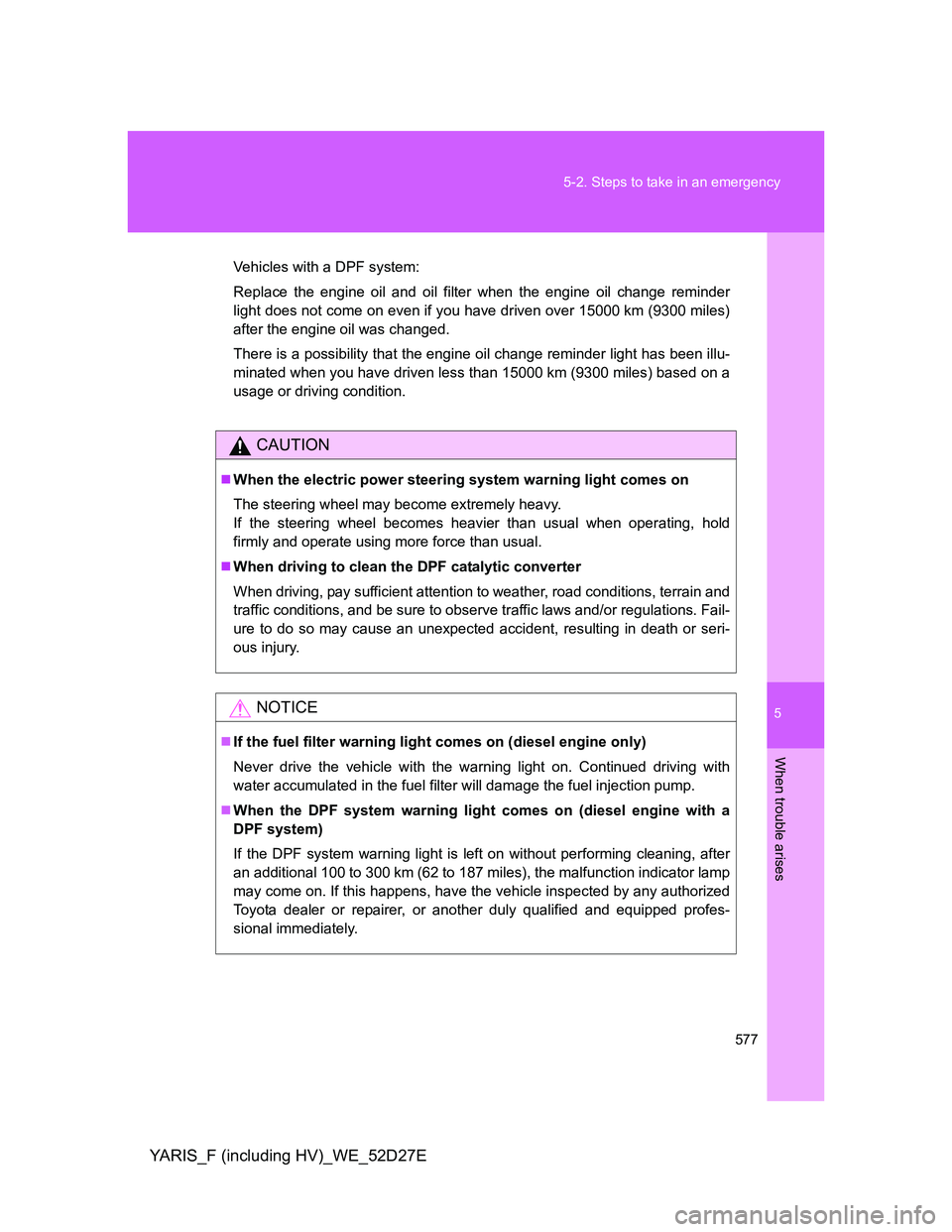
5
577 5-2. Steps to take in an emergency
When trouble arises
YARIS_F (including HV)_WE_52D27E
Vehicles with a DPF system:
Replace the engine oil and oil filter when the engine oil change reminder
light does not come on even if you have driven over 15000 km (9300 miles)
after the engine oil was changed.
There is a possibility that the engine oil change reminder light has been illu-
minated when you have driven less than 15000 km (9300 miles) based on a
usage or driving condition.
CAUTION
When the electric power steering system warning light comes on
The steering wheel may become extremely heavy.
If the steering wheel becomes heavier than usual when operating, hold
firmly and operate using more force than usual.
When driving to clean the DPF catalytic converter
When driving, pay sufficient attention to weather, road conditions, terrain and
traffic conditions, and be sure to observe traffic laws and/or regulations. Fail-
ure to do so may cause an unexpected accident, resulting in death or seri-
ous injury.
NOTICE
If the fuel filter warning light comes on (diesel engine only)
Never drive the vehicle with the warning light on. Continued driving with
water accumulated in the fuel filter will damage the fuel injection pump.
When the DPF system warning light comes on (diesel engine with a
DPF system)
If the DPF system warning light is left on without performing cleaning, after
an additional 100 to 300 km (62 to 187 miles), the malfunction indicator lamp
may come on. If this happens, have the vehicle inspected by any authorized
Toyota dealer or repairer, or another duly qualified and equipped profes-
sional immediately.
Page 606 of 700

606 5-2. Steps to take in an emergency
YARIS_F (including HV)_WE_52D27E
CAUTION
After inflation of the tire has completed, the sealant may splatter when the
hose is disconnected or some air is let out of the tire.
Follow the operation procedure to repair the tire. If the procedures not fol-
lowed, the sealant may spray out.
Keep back from the tire while it is being repaired, as there is a chance of it
bursting while the repair operation is being performed. If you notice any
cracks or deformation of the tire, turn off the compressor switch and stop
the repair operation immediately.
The repair kit may overheat if operated for a long period of time. Do not
operate the repair kit continuously for more than 40 minutes.
Parts of the repair kit become hot during operation. Be careful when han-
dling the repair kit during and after operation. Do not touch the metal part
around the connecting area between the bottle and compressor. It will be
extremely hot.
Do not attach the vehicle speed warning sticker to an area other than the
one indicated. If the sticker is attached to an area where a SRS airbag is
located, such as the pad of the steering wheel, it may prevent the SRS air-
bag from operating properly.
Driving to spread the liquid sealant evenly
Observe the following precautions to reduce the risk of accidents.
Failing to do so may result in a loss of vehicle control and cause death or
serious injury.
Drive the vehicle carefully at a low speed. Be especially careful when turn-
ing and cornering.
If the vehicle does not drive straight or you feel a pull through the steering
wheel, stop the vehicle and check the following.
• Tire condition. The tire may have separated from the wheel.
• Tire inflation pressure. If the tire inflation pressure is 130 kPa (1.3
kgf/cm
2 or bar, 19 psi) or less, the tire may be severely damaged.
Page 648 of 700

648 5-2. Steps to take in an emergency
YARIS_F (including HV)_WE_52D27E
CAUTION
If the engine has to be turned off while driving (except hybrid vehicle)
Power assist for the brakes and steering wheel will be lost, making the
brake pedal harder to depress and the steering wheel heavier to turn.
Decelerate as much as possible before turning off the engine.
Vehicles without a smart entry & start system: Never attempt to remove
the key, as doing so will lock the steering wheel.
If the hybrid system has to be turned off while driving (hybrid vehicle)
Power assist for the brakes and steering wheel will be lost, making the
brake pedal harder to depress and the steering wheel heavier to turn.
Decelerate as much as possible before turning off the hybrid system.
Vehicles without an electronic key: Never attempt to remove the key, as
doing so will lock the steering wheel.
Except hybrid vehicle (vehi-
cles with a smart entry & start
system): To stop the engine,
press and hold the “ENGINE
START STOP” switch for 3
consecutive seconds or more,
or press it briefly 3 times or
more in succession.
Hybrid vehicle (vehicles with
an electronic key): To stop the
hybrid system, press and hold
the “POWER” switch for 3
consecutive seconds or more,
or press it briefly 3 times or
more in succession.
Stop the vehicle in a safe place by the road.
Press and hold for 3 seconds or more,
or press briefly 3 times or more
Press and hold for 3 seconds or more,
or press briefly 3 times or more
Page 669 of 700
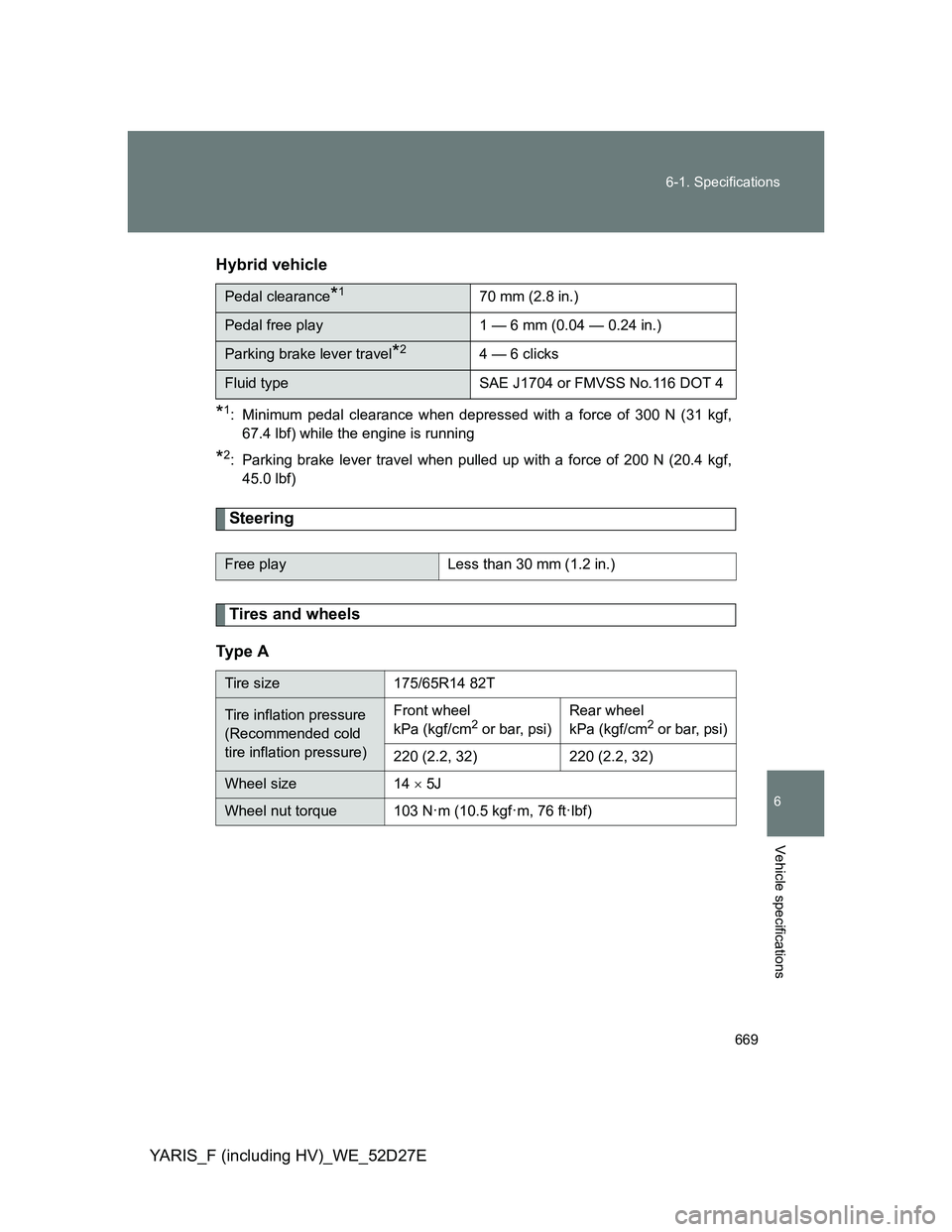
669 6-1. Specifications
6
Vehicle specifications
YARIS_F (including HV)_WE_52D27EHybrid vehicle
*1: Minimum pedal clearance when depressed with a force of 300 N (31 kgf,
67.4 lbf) while the engine is running
*2: Parking brake lever travel when pulled up with a force of 200 N (20.4 kgf,
45.0 lbf)
Steering
Tires and wheels
Ty p e A
Pedal clearance*170 mm (2.8 in.)
Pedal free play 1 — 6 mm (0.04 — 0.24 in.)
Parking brake lever travel*24 — 6 clicks
Fluid type SAE J1704 or FMVSS No.116 DOT 4
Free play Less than 30 mm (1.2 in.)
Tire size 175/65R14 82T
Tire inflation pressure
(Recommended cold
tire inflation pressure)Front wheel
kPa (kgf/cm2 or bar, psi)Rear wheel
kPa (kgf/cm2 or bar, psi)
220 (2.2, 32) 220 (2.2, 32)
Wheel size 14 5J
Wheel nut torque 103 N·m (10.5 kgf·m, 76 ft·lbf)